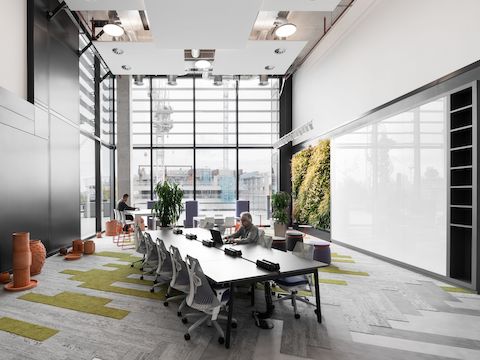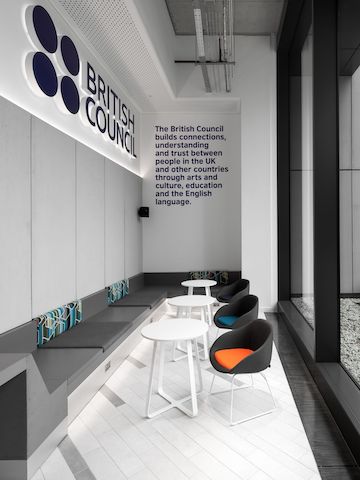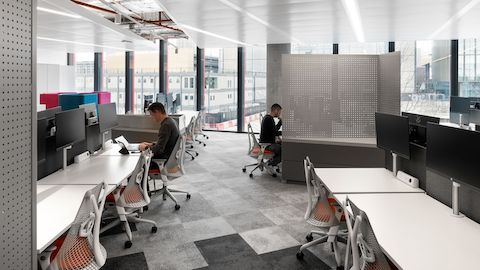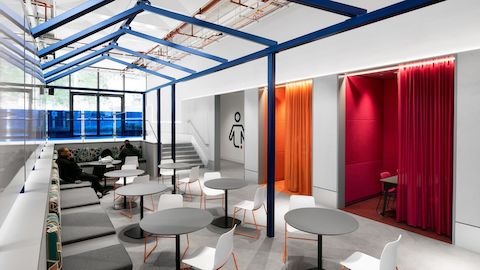British Council
Building Employee Confidence Through Championing Change
London
Download PDF (219 KB)
British Council
British Council
Watch this video of the British Council offices in London supporting agile work spaces.
See what happened when the British Council relocated their headquarters from central London to Stratford’s International Quarter in East London, prompting a change to the working culture of the organization.
Project goals
- Create an HQ which stands out as a key location.
- Enable all teams within the building to be accommodated on a single floor.
- Develop a space which supports activity-based working.
For Damien Bourke, Major Programmes Director at British Council, the success of their new headquarters in Stratford would be down to their staff and how they felt about the new space. “The original office in central London was a challenging space with people spread across seven floors,” says Bourke. “Coupled with a layout that included lots of columns, the space felt very broken up, and teams found it hard to connect with each other.”
Being able to get all the teams into a single floor of the building was therefore a key objective.

Overcoming Issues
By taking advice from workplace consultant Henigan Consulting Group it was possible to understand how the existing space was used – from meeting room usage to types of collaboration. The data from this research was then used to inform the design of the office space. For example, it became apparent that over half of meetings could be held in a more open setting, so the space was planned accordingly.
“By interviewing staff, we were able to get a real understanding of how the old space was, or wasn’t serving people, and how the new space could better accommodate their needs. Looking at it from an activity-based working perspective really helped us create a space to benefit those working there.”
Damien Bourke, Major Programmes Director
In theory, agile working has been in place at British Council since 2012, but in reality, it didn’t really work because there were enough desks for everyone. Bourke explains “We didn’t want to scare people, we had to introduce the concept that there would be fewer desks. And we wanted people to think about the kinds of tasks they would be doing.” He continues “We’ve been able to increase the number of unplanned interactions – people can intermingle and benefit from those ad hoc discussions. You don’t get those when working from home."
British Council has a long-standing relationship with Herman Miller, and following a recent procurement review, are one of the preferred suppliers for the UK and Europe sector. “We had great engagement from Herman Miller from the start,” says Bourke. “They were also really helpful when we moved into the trial phase of the project. People from across the Herman Miller Group were able to present and demonstrate the new furniture from their family of brands to staff.”
To ensure a smooth transition to the new office, Move Champions, were appointed to facilitate the process. “Companies often underestimate the value of change management,” says Mark Catchlove, Director of Herman Miller Insight Group Europe. “By allowing your workforce to feel empowered and included, they are much more likely to respond positively to the new space.”


Adaptable to Change
The British Council’s data-based approach has resulted in a workspace that will support their staff to get their work done, to the best of their ability. Different spaces or settings have been created to support activity-based working: meeting rooms with a choice of sizes, formal workstations for focused, head-down work, and open collaboration spaces for spontaneous brainstorming. Meeting rooms were planned with a global team in mind, ensuring the furniture was focused around the video equipment to ensure remote participants didn’t feel excluded from the layout. Damien Bourke says, “If we can improve the experience of the people elsewhere because of the office then that is the biggest win. Staff won’t need to spend money on train fare to be part of the conversation.”
Designing and outfitting a new space during a pandemic was no doubt challenging but the flexibility of the new British Council space has proved hugely beneficial. “The original aim to deliver a flexible workspace has more than proved its worth in the Covid-19 situation,” says Bourke. “We didn’t need to make any knee-jerk changes. We had already planned for a lower density of people, so we are able to adapt the space easily. “We may not have seen the end of the pandemic and so organizations have to take a much more flexible view of how they organize their spaces.”
The data-driven approach taken by the British Council doesn’t stop once the space is occupied. In Stratford there are sensors monitoring whether people are sat in certain pieces of furniture, most popular routes, and grey areas. Bourke says, “We will be able to see if agile working is actually happening. Is the same person sat at that desk every day, 9-5? What is happening to the dynamic we want to build? Are there areas of social engagement that are helping to fertilize ideas? And is the office delivering on it?”
